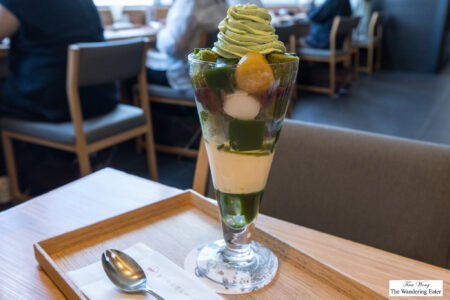


Chinese New Year tray of togetherness, chocolates, tangerines; Pistachios from Wonderful Pistachios; Oolong tea and pistachios on the side
Happy Lunar New Year, everyone! 恭喜發財! In Cantonese, Gong Hay Fat Choy! I wish you all much prosperity and happiness in the new year of the Dragon!
One of the most important days of this holiday is New Year’s Eve. If you were in my family’s kitchen, you’d be stuck in there the day before preparing, rehydrating, chopping, and marinating a whole bunch of ingredients preparing for dishes to cook for this holiday.
While in between, we snack on pistachios from Wonderful Pistachios. The crucial reasoning behind it is because pistachios mean “happy nut” in Cantonese. These pistachios were crunchy, somewhat sweet (it has a particular natural sweetness) yet nicely salted, and so addictive to munch on.
The general theme (related to food) of this holiday is, cooking and eating a bountiful amount of food would bring you luck for the new year. Having leftovers on your table is an auspicious symbol of abundance for the coming year. (I know this whole good luck, fortune, etc. is becoming like a redundant thing but that’s the whole point of this holiday.)




First three courses: Foie gras chawan mushi; Dried scallops Fat choy, and shrimp dumplings
My family’s menu reads like almost every traditional Chinese Year menu. A few are not Chinese dishes like Pat LaFrieda‘s fantastic 2-inch dry aged Angus steak or a foie gras chanwan mushi.



Pat LaFrieda’s whole suckling pig before and after roasting, and chopped
The crowning jewel of this entire meal was the whole roasted suckling pig (as previously mentioned, from the amazing meat purveyor Pat LaFrieda). This beautiful, admittedly adorable animal weighed in at 29 pounds. When my parents glanced at that beast while it was resting on my kitchen counter (marinating, really), they were really excited. Having a whole roasted pig is a sign of prosperity.
As most people presume and think, “You can roast a whole pig at home?” I say, “Why not?” I have a large oven that can fit this animal. (Toward the end of the post, there will be the recipe.) The resulting pig was simply delicious. My entire family was moaning how tasty, succulent and lean the pork was.
Of course, there wouldn’t be a complete meal without desserts. I stuck with the traditional desserts of whole fresh fruits, homemade nian gao (年糕), and bird’s nest soup with red dates (燕窩紅棗甜水).
The bird’s nest soup is a delicacy and status symbol since it is a very expensive ingredient (can fetch up to $10,000 U.S. dollars) beyond that, there are health benefit claims of improving the respiratory system and skin clarity. I don’t know how true are those claims but it tastes fine. You’re really eating this because of it’s texture than flavor (it’s really subtle on the latter).
As for the nian gao, the belief is if you eat this chewy dessert, it would bring you a “higher year” (nian means year; gao means high or cake). Even though many people think you have to purchase this from their local grocery store or bakery, it’s absurdly simple how to make this confection. The recipe is also on the bottom of this post.
Recipes
Roasted whole pig
Ingredients:
Whole suckling pig (preferably within the 20-25 pound range so it would fit most ovens), you can purchase it from your local butcher or a specialized one like Pat LaFrieda
Wet marinade (for the meat/muscle side of the belly):
8 ounces fermented bean sauce
2 ounces hoisin sauce
1 ounce five-spice powder
6 2/3 tablespoons salt
1/2 tablespoon black pepper
Dry marinade (for the skin):
5 tablespoon salt
Approximately 3 fluid ounces of Vodka
Instructions:
1. Mix the wet marinade ingredients in a medium or large sized bowl. In a separate bowl, mix the dry marinade ingredients except for the vodka.
2. Set your pork on a very large clean wire rack that has a sheet pan (or two) underneath that covers the pig. Boil water with a kettle (or saucepan) and pour the hot water on the skin only. Your aim is not to poach your pork in hot water, just scald the skin. This makes the skin tighter and promotes dryness. Pat the pork meat and skin dry.
3. Slather the wet marinade, as evenly as possible, on the muscle/meat portion of the pork belly with your very clean hands or with a brush.
4. Brush or rub the vodka onto the pig skin. Add the salt and spice mixture on the skin and press it on, so it would stick.
5. Let this sit in a cool room or refrigerator, at least overnight. About 2-3 hours prior to roasting, it would be suggested to dry the pork even further with a fan turned on.
6. Preheat the oven to 385 degrees Fahrenheit. Set the marinated pig on a roasting or broiler pan set up with a rack so it will not touch the surface of the pan or the top of your oven, with the skin side up. Oven for approximately 1 hour and 45 minutes.
7. Turn on your broiler to get the pork skin crispy. It should take about 10 minutes but watch it from burning. Once you’ve acquired that gorgeous, dark brown/reddish skin, let it sit to cool for at least 1 hour. Chop into fairly large chunks with a cleaver or heavy chef’s knife (you need the extra weight to cut through the crisp skin and the occasional rib bone). Serve immediately with maybe a little bit of hoisin sauce on the side.
Nian Gao
Makes about 2 8-inch cakes or 1 9×2-inch cake, latter preferred
Ingredients:
1 pound dark brown sugar
1 pound water
1 pound glutinous rice flour
1 tablespoon vegetable or canola oil
1. Place the brown sugar and water into a saucepan. Turn on the heat. Once the brown sugar dissolves, turn off the heat. Set aside to cool until it is room temperature.
2. If you have a KitchenAid stand mixer, pour in the rice flour and the cooled brown sugar-water mixture. Turn on the mixer at its lowest speed (#1) until the mixture is fully incorporated of rice flour. Once it has done that, crank up the speed up to #4 and let it run for 10 minutes straight so your resulting confection would be quite chewy, as it should be. Stir in the vegetable oil.
2a. If you don’t have a stand mixer, you would need to find a medium bowl and a sturdy whisk to withstand the viscosity of the mixture. Pour the rice flour and brown sugar-water mixture into the bowl and start mixing for about 15-20 minutes. The texture when you lift the whisk should have some resistance when you lift and when the batter fall on itself, you would see faint ribbons before it settles back. Stir in the oil.
3. Pour the batter into two greased 8-inch OR one 9-inch aluminum pans, evenly. (Do keep in mind, that for Chinese people, we prefer to have a thicker cake because it is “higher” (or gao) so you would have a “higher” or better new year. )
4. Place the pans into hot steamers and let it cook for about 35-40 minutes (for the 8-inch pans) OR 1 hour (for the 9-inch pan) or when you insert a toothpick, it would come out clean. Leave aside to cool. Slice and serve.
To view more photos of my dinner, please click through the slideshow (or view my Flickr set):
[tylr-slidr userID=”hellokitty893112″ groupID=””]http://www.flickr.com/photos/hellokitty893112/sets/72157628996793745/[/tylr-slidr]






Happy Chinese New Year!
Wow! Those are absolutely fabulous photos! Everything looks very delicious, that tums my stomach altogether. I’m going to try and get the
recipe for the “Nian Gao”. Thank You for sharing you are home cooking recipes!
Happy Chinese New Year Tina!
You are an incredible host! Did you pick up your hosting/cooking/entertaining skills from your parents, or does it come from internal passion?
Susan: Happy Chinese New Year to you as well! Thanks for the compliments and you’re welcome for sharing.
David: Happy Chinese New Year to you and your beautiful family!
Josh: Thank you! Most of my influences are from my parents (traditional Chinese cooking and hosting; baking and European style cooking is from my own passion). Entertaining is more from reading magazines and, one of my odd quirks, reading through old Emily Post’s etiquette books.
You did a whole suckling pig at home!?
Wow! I’m jealous. It looks amazing.
ZenChef: Yup. :) Thanks for the compliment.